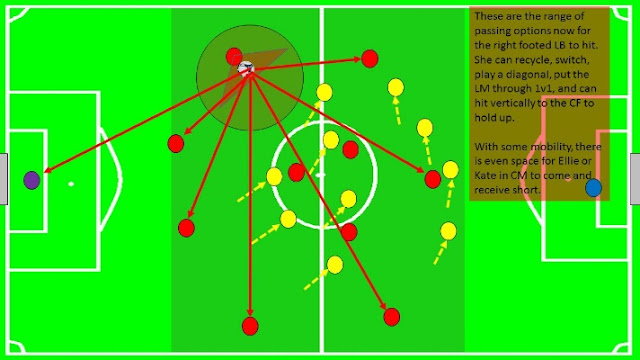In a game back in October between my former Southampton Saints Reserve side and MK Dons, we played our right back over at left back. After the final whistle, she said she enjoyed the role very much. We won the game 6-0, so it's not like she had a lot to do in the defensive department. What she was referring to was her time and space on the ball. It felt like she had a lot more options and thus experienced more success with her ball retention, support structures, and quality of forward passes. I drew some pictures to try and explain why that might be.
As she is predominantly right footed (let's face it, her left leg is simply for standing on), she would always look to receive or control on the right foot. That would turn her body to face inwards, so she could see the whole field. Her first touch would also take her towards the halfspace, meaning she could play in all directions, while not being limited visually like can happen in the centre, and not being limited in terms of space and passing direction, as it happens when near the touchline.
For more on halfspaces, check out this article.
If she was playing on the right, receiving on her right foot, she would most likely only be looking forward, and could easily be forced away from teammates and towards the touchline by the opposition. That severely limits her options to only playing forward, down the line. If the right winger is marked, then what? Hoof it forward to no one. She can't turn round and play back to the goalkeeper, as this would require a 180 degree turn.
MK Dons didn't trouble us much, giving us a bit more space in the bottom of the midfield third. As we weren't troubled by wingers running at her, we could reap the advantages of an inverted full back. Taking a touch towards the middle rather than the touchline kept her more in touch with her teammates, allowing her to combine with the midfield. There's also a much better option for switches and diagonals, since the ball would be on that foot, and she's opened up to play that way.
She began to offer a lot more for recycling through the midfield, feeling far more confident, and taking up much better positions on the left than she would do on the right. Our midfield, that usually panicked and kicked it away to no one, were now primed to turn and play backwards, retaining possession, and allowing us to rebuild our attacks. As the ball went back to her, this provoked movement and taking up of new positions. We created many chances from playing backwards and starting our attacks again. I've always maintained that possession is the best form of defence. The rhythmic passing forced MK Dons back into their own half, as their pressure wasn't good enough to sufficiently test us. If they didn't sit back, they would have been picked apart even more than they were. We were clever and patient, probing, waiting, shifting the ball and creating spaces to eventually play forward.
The women's game relies a lot more on technique and tactics because it is not particularly physical in terms of speed and strength. Whether this would have worked in the men's game remains to be seen. It's one game and one example. We probably would have won the game by three or four goals, as we were good that day. This example of an inverted full back, for a possession team playing against a low block, I believe was a contributing factor in our large victory.






No comments:
Post a Comment